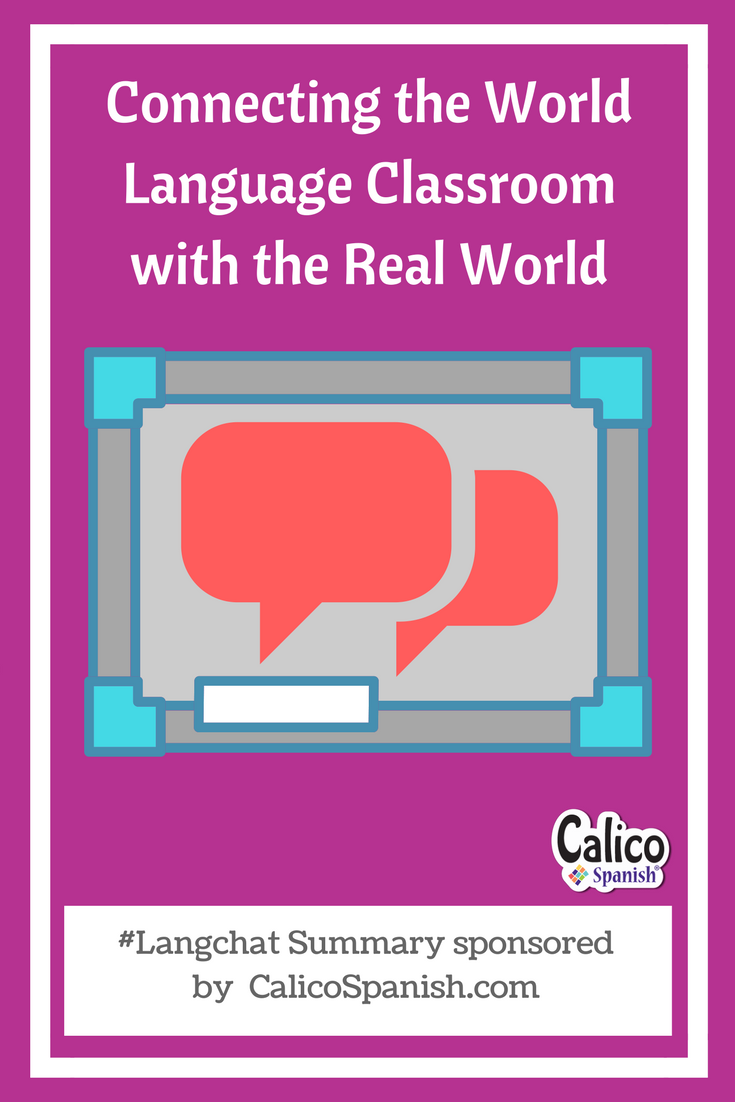Connecting the World Language Classroom with the Real World
 Interactions with real-world language scenarios and activities increase language motivation levels for many students. In last week’s fast-paced chat, participants shared a plethora of creative ideas for how to accomplish making target languages a reality for students without ever needing to leave the classroom or surrounding community.
Interactions with real-world language scenarios and activities increase language motivation levels for many students. In last week’s fast-paced chat, participants shared a plethora of creative ideas for how to accomplish making target languages a reality for students without ever needing to leave the classroom or surrounding community.
– Follow the blog on Bloglovin –
Preparing Students BEFORE They Engage in Real-World Experiences
Although #langchat teachers cannot equip students for every real-world encounter they will face, many teachers have come up with the following strategies to enhance student preparedness:
- @SrtaOlson said, “I think that establishing a positive relationship and learning environment for [students] will encourage them to take more risks.”
- @VTracy7 believes that “circumlocution is probably their strongest tool for #reallife.”
- @espanolsrs said, “Ask them to give the “Why” to back up their responses in [target language].”
- @sr_connolly shared, “Engage in authentic scenarios [with] authentic materials: art, politics, sports, pop culture. Language opens so many doors.”
- @CoLeeSensei said, “You can prep them with vocab, you can prep them with grammar, but ultimately the best prep is the interpersonal practice.”
– Like Calico Spanish on Facebook –
Real World Language Scenarios that Engage Novice Learners
There are many ways to introduce real world language scenarios to students. Technology has opened a world of opportunities for teachers and students. Diversity within cities and communities have also allowed for extended interaction and practice of target languages. @SrtaOlson said:
When [students] see the target culture right in their own backyard, their love for the language will only grow stronger = MOTIVATION.
#Langchat teachers shared the following ideas to engage students in real-world scenarios:
Classroom-Based:
- @GrowingFrench said “my favorite is trip planning- plane, train, hotels, restaurants, itinerary, museums.”
- @ProfeMcNeely suggests practicing with “daily routines and food. My students LOVE being able to apply their knowledge at their [favorite] restaurant.”
- @AHSblaz mentioned, “In April, our 2 [year] pen pals are coming to visit!”
- @LauraErinParker “had upper levels do story books to send to Haiti. Maybe have novices do picture books this time?”
– Follow Calico Spanish on Twitter –
Community-Based:
- @rlgrandis said, “In [the] fall, my [students] served food at a Hispanic outreach event. Great practice of “Quiere…? mucho o poco? pollo o vegetariano?”
- @ShannonRRuiz said, “Our students went to assisted living centers to read to Spanish-[speakers] (practice pronunciation). [Students] had to practice intros beforehand.”
- @ShannonRRuiz added, “Higher levels can reach out to businesses or even schools to help translate printed materials for them.”
- @la_sra_hinson said, “I also have a plan to get them [with] local pet shelter to get pets adopted by creating ads for them in Spanish.”
Technology-Based:
- @MlleSulewski said, “Online is so easy these days with social media! Getting involved with my French teacher-friend for anti-bullying campaign.”
- @LauraErinParker said, “Not a lot of French speakers in area, so reach out to friends – fellow teachers, native speakers, etc. through technology!”
- @Becky_Skogen suggests, “WeSpeke!!! I had a kid tell me they helped prepare partner for an English test for a new job.”
- @AHSblaz encourages students to “shop online, explore virtual visits to schools, rent apt, etc.”
– Follow us on Instagram too! –
Bridging Real-World Scenarios with Existing Curriculum & Strategies
The “real world” is always changing and sometimes curriculum struggles to keep up with is happening outside of the classroom walls. @LauraErinParker gave some advice and said, “The key is looking for a way to make what they are doing useful past the class and me.” This concept may be easier said than done. However, @ShannonRRuiz said:
Sometimes you have to creatively mix and match [curriculum] to fit the scenario. Takes guts to buck the system that way.
While engaging students, “try to get rid of scenarios that few (if any) will ever do. Instead of being a doctor in a country, how can we adapt realistically?” asked @MlleSulewski. @SECottrell said that it is important to “leverage the existing structures to ask what relevant, real-world assessment can be made with them.” Finally, #langchat participants emphasized the fact that since language and the world are always changing, curriculum should too.
Thank you
Thank you to our lead moderator, Laura (@SraSpanglish) and co-moderators, Megan (@MlleSulewski) and Colleen (@CoLeeSensei) for guiding the conversation about connecting the world language classroom with the real world. Thank you to all #langchat participants for making this discussion possible! Have a topic you would like to discuss? Check out the #langchat wiki and suggest a topic!






No Comments